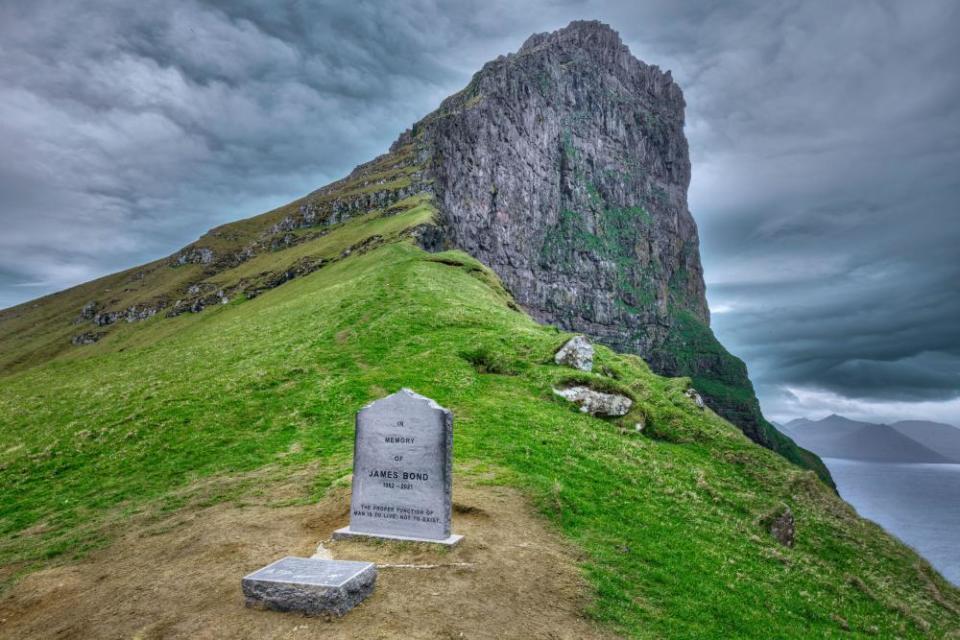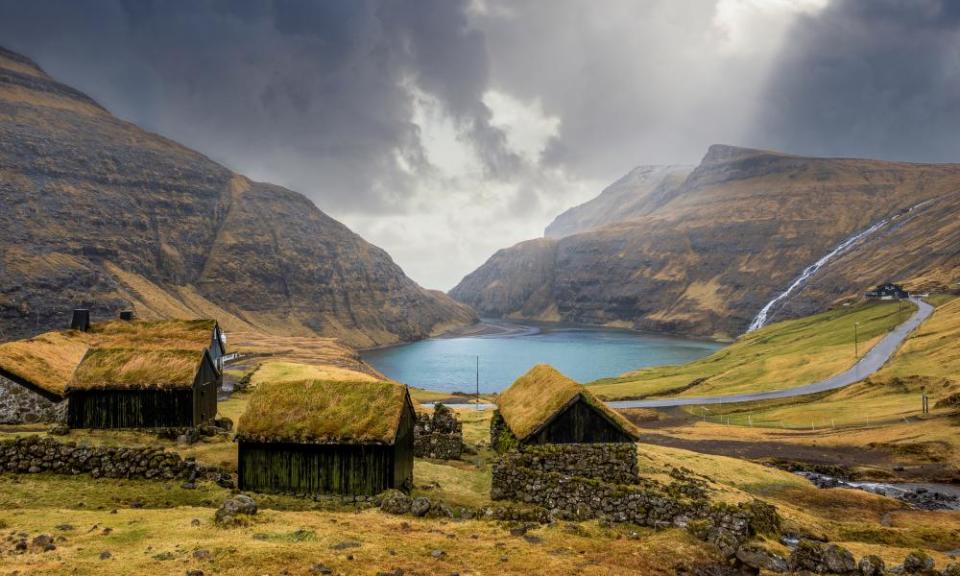The first snow has fallen on the sharp ridge below the 700 meter high peak of Víkartindur. As we walked the village path towards Saksun, we looked at the ridge that runs along the spine of the neighboring island of Eysturoy. The jagged landscape was bathed in golden winter light and in the distance the Atlantic Ocean was a gigantic silver-plated mirror.
We saw no one else on the twelve mile walk, just a few white mountain hares darting between the rocks. Since it is hunting season, my local guide, Høgni Reistrup, had checked with local farmers to make sure no one would shoot where we were walking. Hiring a guide makes sense on these steep slopes, where the weather is notoriously changeable and fog can descend quickly.
With around 300 days of rain per year, the rise of tourism in the Faroe Islands is something new. Numbers have doubled in the past eight years, largely thanks to innovative social media campaigns featuring craggy mountain peaks, cuddly sheep and rustic wooden houses. But whether tourists should pay to hike in these mountains and sheep pastures is a hotly debated topic.
Currently, anyone, local or foreigner, can walk along village paths in the countryside, but many of the places made famous by social media influencers are on private land where there is no automatic right to roam. Some farmers are now taking advantage of the old Faroese land law to cash in on the increasing number of hikers wanting to explore the dramatic landscape.
Charges have been introduced at several tourist hotspots (usually 200 Danish krone – around £23), including at the famous ‘floating lake’ at Trælanipa, the lagoon at Saksun and the sea stacks at Dunnesdrangar. Next summer there are plans to ask hikers to climb the Faroe Islands’ highest peak, the 880-metre-high Slættaratindur. Meanwhile, the westernmost island, Mykines, has already introduced a £60 tourist tax and restricted access to the puffin breeding areas that attract many thousands of visitors. Landowners say the money is intended as compensation for disruption to agriculture and nature.
Tourism now generates almost £100 million a year – around 6% of the islands’ GDP. There are only 55,000 Faroese, but visitor numbers are around 110,000 per year, most arriving in June, July and August. This figure includes about 40,000 people who visit for a few hours on cruise ships. A new tourism strategy launched this month aims to make the most of the idea that the islands embody the concept of ‘Heim’ (home) for visitors and locals alike.
Guðrið Højgaard, the director of Visit Faroe Islands, says the goal is for locals to own at least 80% of the tourism sector. However, she acknowledges that the speed of tourism development has taken the islands by surprise. “The last thing we want is for Faroese people to see tourists as a problem.”
As the numbers have increased, I have had to hire guides. It is fair that farmers get a share of the tourist income
Jóhannus Kallsgarð, farmer
I have been walking in these mountains for more than ten years and have seen a certain tension developing between the tourism industry and the Faroese farmers. Recently, two hikers were fined by police for the first time for trespassing after refusing to pay to visit one of the most popular viewpoints on the islands. It happened on Kalsoy, now informally known as the ‘James Bond Island’ because it was used as the location for the climax of No Time to Die.
Local farmer Jóhannus Kallsgarð has enterprisingly erected a granite tombstone marking Bond’s fictional resting place, and his clifftop pasture attracted more than 15,000 walkers this summer. He charged a fee of 200 Danish krone this year, and a shuttle bus service was introduced to ease pressure on the small inter-island car ferry that takes visitors to the island.

“My family has been farming here for fifteen generations, and as a boy I hardly saw any outsiders in the village from one month to the next. We welcome tourists and in 2019 I took more than 200 hiking groups to the lighthouse,” says Kallsgarð. “As the numbers kept increasing, I had to hire guides to help people hike safely because every year we have guests who slip on the trail and injure themselves. I think it is fair that farmers get a share of the tourist revenue.”
I don’t like the idea of paying a fee to visit nature. But protecting the land is necessary – perhaps through a government tourist tax
Óluva Zachariasen
There is debate about whether too many tourists have an effect on the country. Høgni Hoydal, the Minister of Trade and Industry, says plans will be submitted to parliament to regularize the issue of public access to the country. “Agriculture was our lifeblood for centuries,” he says, “and our oldest written document is the ‘Sheep Letter’ from 1298, which sets out the rules on compensation for trespass. But if tourists pay a fee or environmental tax, we must ensure that the money is used to protect nature. And I don’t think people should charge money without offering a service.”


According to the tourist board, the issue of public access should be decided by the politicians. “Almost all of our land is reserved for sheep,” says Højgaard, “and we recognize that our historic relationship with these animals is part of what makes the Faroe Islands an authentic destination. However, we have control over how quickly the number of tourists will continue to rise, and I don’t think we have too many. It is in balance.”
The number of tourists at the most popular spots remains relatively small: about 80 people climb Slættaratindur every day, and about 2,500 hike up the mountain in August. In the far north, the increase in boots on the ground inevitably leads to erosion.
Óluva Zachariasen is an avid hiker and sheep owner who has founded a rural association to draw attention to this problem among Faroese hikers. “In principle, I don’t like the idea of paying a fee just for nature visits. However, where there are large numbers of tourists or walkers of any nationality, protection of the land is necessary, perhaps through a government tourist tax. It is an emotional cultural issue for us Faroese, and we have a long history of disputes on our islands over grass and land.”
The trip was arranged by Guide to the Faroe Islands . Smyril line sails twice a week from Hirtshals in Denmark with seven-night packages including ferry (plus vehicle); seven nights in Tórshavn from £1,032 pp